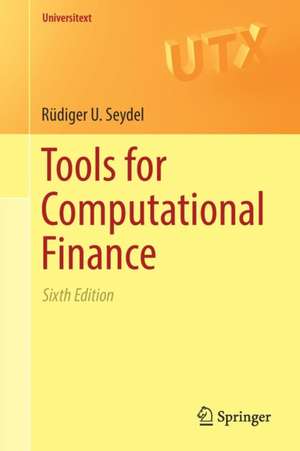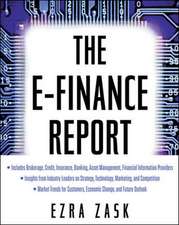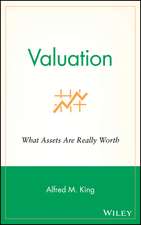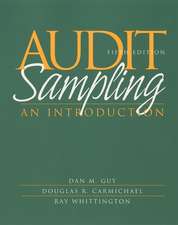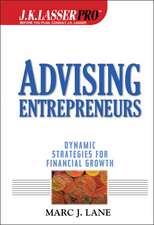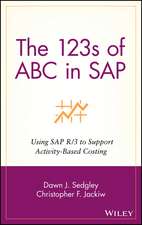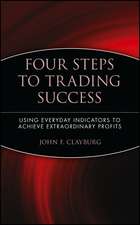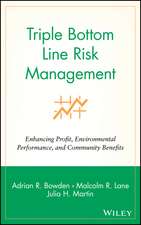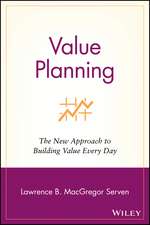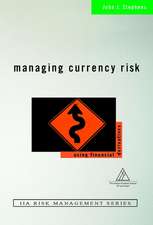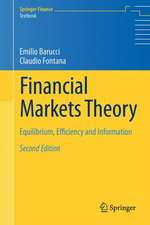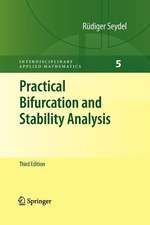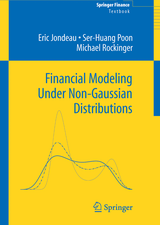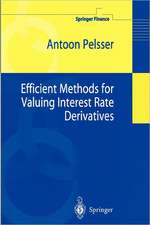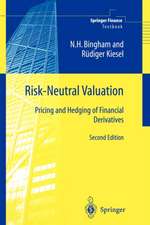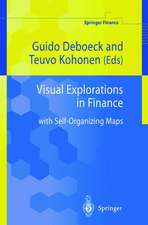Tools for Computational Finance: Universitext
Autor Rüdiger U. Seydelen Limba Engleză Paperback – 29 aug 2017
Now in its sixth edition, Tools for Computational Finance has been significantly revised and contains:
- Several new parts such as a section on extended applications of tree methods, including multidimensional trees, trinomial trees, and the handling of dividends;
- Additional material in the field of generating normal variates with acceptance-rejection methods, and on Monte Carlo methods;
- 115 exercises, and more than 100 figures, many in color.
Interdisciplinary in nature, this book will appeal to advanced undergraduate and graduate students in mathematics, engineering, and other scientific disciplines as well as professionals in financial engineering.
Din seria Universitext
- 13%
 Preț: 353.48 lei
Preț: 353.48 lei -
 Preț: 418.67 lei
Preț: 418.67 lei -
 Preț: 465.61 lei
Preț: 465.61 lei -
 Preț: 371.98 lei
Preț: 371.98 lei - 17%
 Preț: 394.41 lei
Preț: 394.41 lei -
 Preț: 356.77 lei
Preț: 356.77 lei - 17%
 Preț: 364.56 lei
Preț: 364.56 lei - 15%
 Preț: 543.75 lei
Preț: 543.75 lei - 15%
 Preț: 497.21 lei
Preț: 497.21 lei -
 Preț: 634.38 lei
Preț: 634.38 lei -
 Preț: 396.53 lei
Preț: 396.53 lei - 17%
 Preț: 427.68 lei
Preț: 427.68 lei - 13%
 Preț: 355.51 lei
Preț: 355.51 lei -
 Preț: 360.07 lei
Preț: 360.07 lei - 17%
 Preț: 365.34 lei
Preț: 365.34 lei -
 Preț: 358.44 lei
Preț: 358.44 lei - 15%
 Preț: 553.33 lei
Preț: 553.33 lei - 17%
 Preț: 364.81 lei
Preț: 364.81 lei -
 Preț: 673.45 lei
Preț: 673.45 lei - 15%
 Preț: 509.58 lei
Preț: 509.58 lei - 17%
 Preț: 427.32 lei
Preț: 427.32 lei - 17%
 Preț: 426.76 lei
Preț: 426.76 lei - 8%
 Preț: 495.43 lei
Preț: 495.43 lei - 20%
 Preț: 569.54 lei
Preț: 569.54 lei - 19%
 Preț: 429.21 lei
Preț: 429.21 lei - 17%
 Preț: 369.06 lei
Preț: 369.06 lei - 15%
 Preț: 737.46 lei
Preț: 737.46 lei - 13%
 Preț: 389.95 lei
Preț: 389.95 lei -
 Preț: 487.96 lei
Preț: 487.96 lei - 20%
 Preț: 628.22 lei
Preț: 628.22 lei -
 Preț: 372.86 lei
Preț: 372.86 lei -
 Preț: 319.07 lei
Preț: 319.07 lei -
 Preț: 379.86 lei
Preț: 379.86 lei -
 Preț: 445.88 lei
Preț: 445.88 lei -
 Preț: 382.36 lei
Preț: 382.36 lei - 15%
 Preț: 533.72 lei
Preț: 533.72 lei - 15%
 Preț: 496.02 lei
Preț: 496.02 lei - 15%
 Preț: 474.82 lei
Preț: 474.82 lei -
 Preț: 389.70 lei
Preț: 389.70 lei -
 Preț: 484.08 lei
Preț: 484.08 lei - 15%
 Preț: 469.41 lei
Preț: 469.41 lei - 15%
 Preț: 643.48 lei
Preț: 643.48 lei -
 Preț: 415.02 lei
Preț: 415.02 lei - 15%
 Preț: 602.25 lei
Preț: 602.25 lei - 20%
 Preț: 510.24 lei
Preț: 510.24 lei - 15%
 Preț: 588.37 lei
Preț: 588.37 lei -
 Preț: 381.59 lei
Preț: 381.59 lei -
 Preț: 489.87 lei
Preț: 489.87 lei -
 Preț: 493.89 lei
Preț: 493.89 lei
Preț: 537.97 lei
Preț vechi: 632.90 lei
-15% Nou
Puncte Express: 807
Preț estimativ în valută:
102.94€ • 107.77$ • 85.18£
102.94€ • 107.77$ • 85.18£
Carte tipărită la comandă
Livrare economică 05-19 aprilie
Preluare comenzi: 021 569.72.76
Specificații
ISBN-13: 9781447173373
ISBN-10: 1447173376
Pagini: 459
Ilustrații: XXII, 486 p. 109 illus., 50 illus. in color.
Dimensiuni: 155 x 235 x 33 mm
Greutate: 0.71 kg
Ediția:6th ed. 2017
Editura: SPRINGER LONDON
Colecția Springer
Seria Universitext
Locul publicării:London, United Kingdom
ISBN-10: 1447173376
Pagini: 459
Ilustrații: XXII, 486 p. 109 illus., 50 illus. in color.
Dimensiuni: 155 x 235 x 33 mm
Greutate: 0.71 kg
Ediția:6th ed. 2017
Editura: SPRINGER LONDON
Colecția Springer
Seria Universitext
Locul publicării:London, United Kingdom
Cuprins
1 Modeling Tools for Financial Options.- 2 Generating Random Numbers with Specified Distributions.- 3 Monte Carlo Simulation with Stochastic Differential Equations.- 4 Standard Methods for Standard Options.- 5 Finite-Element Methods.- 6 Pricing of Exotic Options.- 7 Beyond Black and Scholes.- A Financial Derivatives.- B Stochastic Tools.- C Numerical Methods.- D Extended Tree Methods.- E Complementary Material.- References.- Index.
Notă biografică
Rüdiger U. Seydel is professor emeritus of numerical analysis. He is the former head of a research group on computational finance at the University of Cologne. He also worked in bifurcation and dynamical systems.
Textul de pe ultima copertă
Computational and numerical methods are used in a number of ways across the field of finance. It is the aim of this book to explain how such methods work in financial engineering. By concentrating on the field of option pricing, a core task of financial engineering and risk analysis, this book explores a wide range of computational tools in a coherent and focused manner and will be of use to anyone working in computational finance. Starting with an introductory chapter that presents the financial and stochastic background, the book goes on to detail computational methods using both stochastic and deterministic approaches.
Now in its sixth edition, Tools for Computational Finance has been significantly revised and contains:
Interdisciplinary in nature, this book will appeal to advanced undergraduate and graduate students in mathematics, engineering, and other scientific disciplines as well as professionals in financial engineering.
Now in its sixth edition, Tools for Computational Finance has been significantly revised and contains:
- Several new parts such as a section on extended applications of tree methods, including multidimensional trees, trinomial trees, and the handling of dividends;
- Additional material in the field of generating normal variates with acceptance-rejection methods, and on Monte Carlo methods;
- 115 exercises, and more than 100 figures, many in color.
Interdisciplinary in nature, this book will appeal to advanced undergraduate and graduate students in mathematics, engineering, and other scientific disciplines as well as professionals in financial engineering.
Caracteristici
Provides a broad understanding of practical techniques and algorithms Ventures deep into the subject area while assuming only minimal background knowledge Includes many exercises and numerous illustrations
